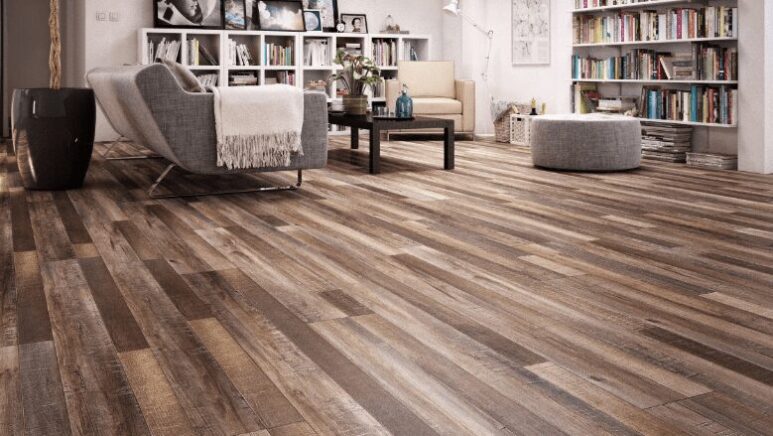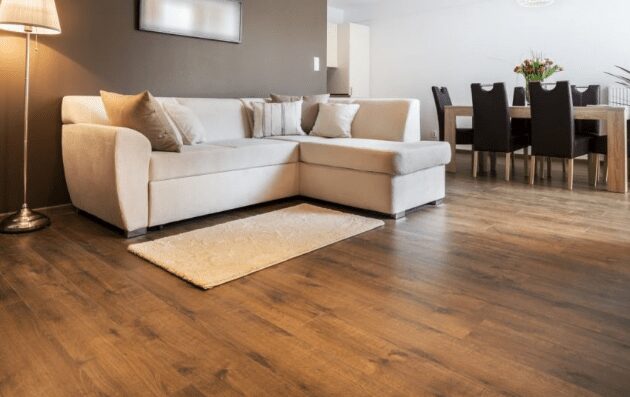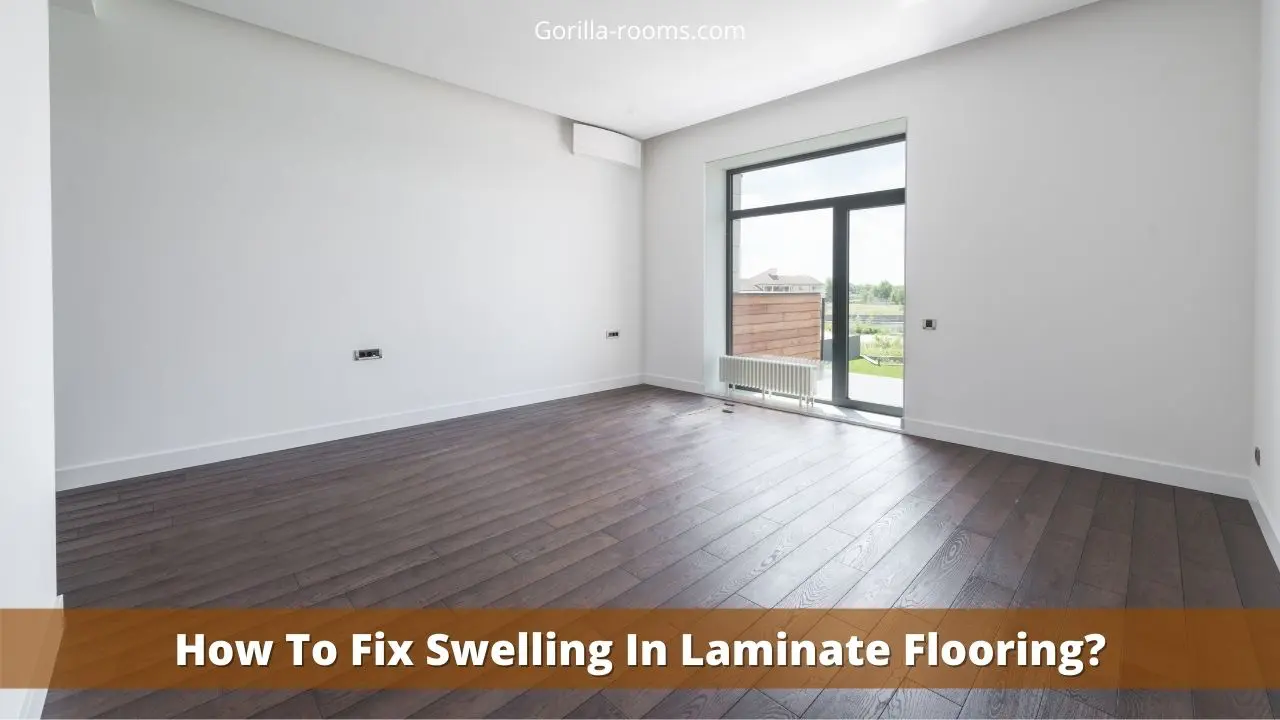With laminate flooring, you get the feel of a natural wood surface while still having a highly durable flooring material. However, its ability to withstand high traffic makes it the most popular choice for homeowners.
By replacing the bubbling-up plank, you can quickly fix this problem. There is, however, a cost associated with buying new planks. So, how can you replace swollen laminate flooring without replacing it?
We have discussed the following methods to fix swelling in laminate flooring.
How To Repair Swelling In Laminate Flooring

Things You Need In This Method
- Towel, cloth, or duster.
- Measuring scale or any other instrument
- Hammer
- Crowbar
- Knife
- New planks.
Inspect Your Floor
Examine the area of your floor that is bubbling carefully. Check your floor for bubbles. It is necessary to remove a board if bubbles appear on it.
You might experience excessive moisture from leaking pipes, flooding from faulty appliances like dishwashers, or even an expansion gap issue. You’ll need to figure it out quickly either way.
Mark the damaged areas with a sticky note, marker pen, or colored tape. When you are relatively inexperienced with installing and maintaining laminate floors, you might want to hire an expert to look at it.
Stop The Leak
Sometimes laminate flooring swells because it has absorbed moisture from the atmosphere or the floor itself.
If you have determined that this is the cause, first, you will want to eliminate the source of water. Check your home’s plumbing and make sure that there aren’t any leaks making their way under the laminate.
Unless you stop the leak, you won’t be able to repair the damage. The first step in fixing a leak is to locate the source of the water.
There are many reasons for laminate flooring flooding, but faulty appliances (leaking dishwashers are a common cause), leaking toilets, and burst pipes are the most common.
Dry The Laminate
In most cases, you can use a hairdryer to dry laminate that has swelled due to moisture. As you apply a hairdryer to the swollen flooring, you will notice it is contracting.
After that, use a roller or straight edge to flatten it out. The laminate will need to be replaced if it begins to swell even more while drying.
If you are using a towel, cloth, or duster, wipe them with overlaminate to make them dry.
Flatten With A Roller
When expansion and contraction gaps are not sufficient, laminate flooring tends to expand and buckle.
There should be small gaps around the perimeter of the floor where the flooring meets the molding. To allow the floor to move naturally, they should be between 14″ and 12″.
You may need to cut these gaps if you see your flooring buckle. You can flatten the buckles with a 100lb roller after cutting the gaps.
If these gaps remain, your laminate flooring should have plenty of space to expand and stay flat.
Determine How many Planks Need To Be Fixed
The next step will be to determine how much laminate flooring needs to be repaired due to flooding.
Examine your laminate flooring in each room. Check for bubbled or warped boards and note boards that don’t fit evenly together. Tape or apply sticky notes to damaged areas to mark them.
Remove Damage Planks
As soon as the damaged planks are removed, you can begin fixing the damaged areas. Make sure you have all the tools you will need before beginning this part of the project.
The tools you’ll need most often are a hammer, crowbar, and utility knife.
Replace Damage Planks
After removing the damaged planks from the affected area, you’ll need to replace them with new ones.
Even though this is a very approachable DIY project, many people find it intimidating since it can be challenging to match the new laminate planks with the laminate planks you already have.
Instead of using your extra planks, head to your local home store and find planks that match your current planks with the most fantastic accuracy. Once the planks are installed, a slight variation won’t make a big difference.
After finding the replacement planks, install them on top of your current planks, being careful not to damage them with nails or other hazards exposed by removing the old laminate flooring.
What Causes A Laminate Floor To Swelling

Your laminate floor may swell, bubble up, and buckle due to the following reasons:
Moisture Problem
First and foremost, a high humidity level is responsible for bubbling up laminate surfaces. A laminate floor will not remain dry if it has leaking pipes or a poor moisture barrier. As a result, it starts swelling over time.
As the laminate base can’t withstand water, even a small spill can cause this issue.
Delamination
Another factor that may cause the floor to swell up is delamination. The laminate base will puff if the planks are not installed correctly or damaged when installed.
When There Is No Gap Between The Planks
Due to temperature changes, the laminate plank will expand over time. Planks start lifting if the installer leaves no gaps.
As a result, your laminate base begins to bubble. Therefore, tightening the molding will result in swelled floors.
Lack Or No Expansion joints
It is necessary to leave a gap between the laminate floor sections when installing it in a large area. When laminate planks are installed in large sizes, air may get trapped under them, which will cause the surface to swell up.
Furthermore, a poorly installed plank will also cause the laminate base to bubble up. Do not interfere with the floor’s venting system or install the moisture barrier incorrectly.
A bubble will start forming over time if you do not do that.
How to Prevent Swelling in Laminate Flooring
To prevent swelling in laminate flooring in the future, the following precautions should be taken:
- If your laminate surface is wet for an extended period, make sure you wipe it off right away. Remove the water as soon as possible.
- Clean up the wet area as soon as the water is spilled.
- Your laminate flooring cannot handle moisture well, so do not mop it.
- Keep your room’s humidity level between 35 and 65 percent. To maintain this level, you can use a dehumidifier.
- A quarter-inch or a half-inch space should be left for expansion and contraction since the laminate surface expands with time.
- A moisture barrier will prevent the floor from buckling or absorbing moisture.
- Cooling the house with an air conditioner in summer helps to reduce humidity.
- When cleaning laminate floors, use only products that are recommended.
- When you encounter a flooring problem, always seek the advice of a flooring expert.
Final Words
After reading the above article, we hope you must have known how to fix the swelling in laminate flooring.
Moreover, now you have learned about the factors which cause a laminate floor to swell. Additionally, to prevent swelling in the future, you must take the above precautions.

